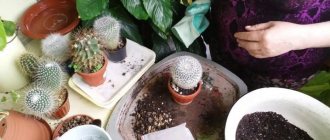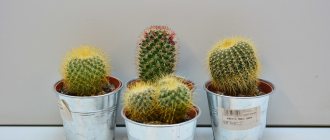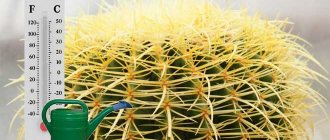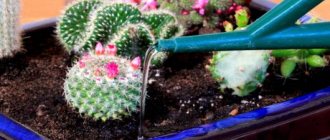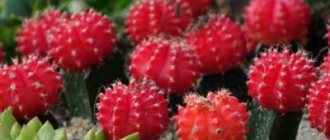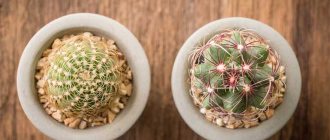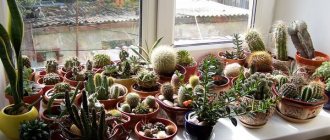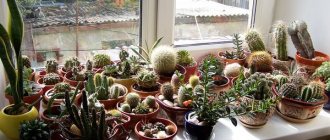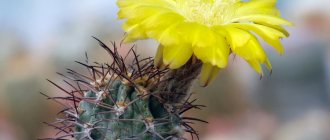Hot and inaccessible South America is the real birthplace of the Decembrist houseplant
Many who are involved in breeding indoor plants have already found out the homeland of the Decembrist plant a long time ago in order to properly navigate how best to care for it, what conditions to create and what to feed it ideally. As we have already said, this is an epiphytic cactus, completely devoid of needles, which mainly grows in the warm tropical forests of South America, on snags, stumps, and also directly on tree trunks, in conditions of significantly increased humidity. Thus, the homeland of the Decembrist is known, it is not a secret, let’s figure out how he got from there to our comfortable conditions of city apartments and private houses.
Decembrist flower: origin of the name
Those who are interested in the birthplace of the Decembrist should first figure out where its scientific and colloquial name came from, and only then move on. In the mid-nineteenth century, a famous botanist and breeder, as well as an avid collector from France, named Frederic Schlumberger, first proved that the Decembrist was indeed a cactus when he grafted its shoots onto Pereskia spinosa. Another scientist, a taxonomist named Charles Lemaire, decided that the scientist deserved to perpetuate the name of his colleague, so this cactus was called Schlumbergera, in the German manner of pronunciation.
True, for the most curious, it is worth clarifying that there is another scientific name for the Decembrist, namely zygocactus, which comes from the Greek word meaning “yoke”. Moreover, to be honest, the birthplace of the Decembrist flower has absolutely nothing to do with it, and the name is based on the fact that the stems of the plant, consisting of segments, are always divided exclusively in two. That is, in living nature, one shoot can produce two, but three, four or more will never grow. True, it should be recognized that selection, that is, bred species can already produce three or more shoots, as well as several flowers on one.
The name Decembrist, which is familiar to us, appeared thanks to a growing season unique to our latitudes. The homeland of the Decembrist plant gave us a similar gift, for which we are immensely grateful to her, because it blooms in December and can continue to bloom until March. Thus, it becomes completely clear not only where the Decembrist flower comes from, but also why it bears such a name. It turns out that hot Brazil can definitely be called the country of origin of the Decembrist, as well as Argentina, Peru and even a little Mexico, where this species most often grows.
Where do cacti grow in nature: habitat conditions
Features of caring for pets
The homeland of the prickly plant cactus (from the Greek cactos) is South and North America. The center of family formation is still considered to be South America, from where they spread to the North American continent. Where cacti grow, there can be completely different conditions, because these plants have a huge distribution area, covering different natural zones. This in itself determines a wide variety of plant growth conditions: climatic, zonal and soil. Cacti inhabit tropical forests (epiphytic species growing on tree trunks), savannas, various types of deserts and semi-deserts, and in the mountains they rise to an altitude of 4500 m above sea level. Where else do cacti grow in the wild? Most of these succulents are adapted to life in desert conditions, with little rainfall and sharp temperature changes from day to night. Particularly harsh environmental conditions for cacti are characteristic of high-mountain deserts with their negative night temperatures and the difference between day and night temperatures on the soil surface up to 45°. To the north, the range of cacti extends to 56° N. sh., and south to 54° S. w. The extreme points of the range are reached mainly by representatives of the Opuntaceae subfamily.
The habitat of cacti across continents is extremely uneven. The greatest species diversity is characteristic of Mexico, the mountain deserts of Peru, Chile, Argentina and Bolivia.
Cacti are plants that have high ecological plasticity. Certain signs of cacti's adaptability allow them to survive not only in North and South America, but also in various natural zones of other continents. Thus, some types of prickly pear were brought to Western Europe and successfully acclimatized. In the former USSR, prickly pears were acclimatized in the Crimea and Astrakhan region, as well as in Turkmenistan. Some types of epiphytic cacti are found in the forests of Africa, Madagascar, Sri Lanka and the islands of the Indian Ocean. However, it is believed that they were brought to these places by humans.
Flowering species
- Astrophytum , or Star Cactus , is found naturally in northeastern Mexico. They have a spherical or star-shaped shape and expressive ribs, which can be from 5 to 10. The ribs of some varieties are covered with thick white hairs. This species has large flowers of various shades of yellow, sometimes reddish.
- Echinocereus - cylindrical in shape, up to 130 cm high, dormant for 5-6 months (without watering). They have beautiful cup-shaped flowers that reach up to 10 cm in diameter.
- Echinocactus Gruzona - this cactus is found in nature mainly in Mexico. It has the shape of a ball and reaches quite large sizes: it can grow up to a meter in height with a diameter of 50-80 cm. This cactus has from 20 to 35 ribs with small areoles, which are covered with piles, from which golden-yellow spines 3-5 long grow cm. Only old specimens bloom; the flowers are large and yellow.
- Echinopsis is native to Young America. Characterized by great variability: they can have a spherical, cylindrical or columnar shape. Very easy to grow and easy to bring to flowering. The flowers appear at night, long, funnel-shaped.
- Ferocactus - grows naturally in the USA and Mexico. They have a spherical appearance, becoming more cylindrical over time, and have long, strong spines. They bloom only when they reach a height of at least 25 cm. The flowers are funnel-shaped and can be yellow, pink or red. These are daytime flowers and close at night.
- Mammillaria - found naturally in the USA, Mexico and northern South America. About 160 species of Mammillaria are known. These cacti are small, grow up to 30 cm in height and are mostly spherical in shape. They have no ribs. The flowers are shaped like tubes, bells or flat circles.
- Notocactus - found in Brazil and Argentina. They have a spherical shape, becoming more cylindrical with age. It blooms with beautiful large flowers, yellow, orange, red, pink.
- Opuntia - found naturally in North and South America. They have many different forms. They bloom with beautiful flowers, yellow, orange or red.
If you have something to add, please be sure to leave your comment on the site
Application
How to care for succulents?
All parts of this plant are used in different fields. Flowers, cladodes, berries are used in:
- Cosmetology
- Cooking
- Agriculture
- Traditional medicine
Prickly pear flowers produce valuable oil that has anti-aging properties. It is used in the preparation of face and hair masks. It is also added to anti-aging creams. Vitamin E restores cellular structure, increases the turgor of the epidermis, nourishes and moisturizes it. This is an antioxidant that helps prolong skin youth.
Organic acids obtained from cactus pulp are used to make masks and creams for dull skin. Their use helps tighten problem areas of the face and neck and regenerates the cellular structure. Prickly pear fruit extract is added to tanning products and ointments for burns.
Cactus branches and leaves are fed to domestic animals. Thorns are removed by burning the collected parts of the plant. After heat treatment, the pulp becomes softer and more palatable. For feeding, fodder species of prickly pear are used, which are grown specifically for this purpose.
Prickly pear juice is used in folk medicine. Compresses are made from it to heal wounds and accelerate bone healing in case of fractures. These procedures also help with rheumatism and joint pain. Local residents use decoctions of dried fruits to treat vitaminosis and diseases associated with weakened immunity. Berry tincture helps against urinary tract diseases. Drinks from the flowers and roots of the plant improve the functioning of the prostate gland in men and prevent prostatitis.
Not only prickly pear berries are used in cooking, but also the pulp. Young shoots, the size of which is no more than 10 cm, are suitable for consumption. They are cut and eaten fresh or processed. Cladodes can be dried, pickled, stewed, baked. The Indians have long made various drinks using the pulp of cacti.
Prickly pear fruits have a more delicate and pleasant taste. They are eaten raw, and the following dishes are also prepared from them:
- sweet salads;
- jelly, marmalade;
- candies;
- preserves, jams;
- juice, wine, cocktails.
Botanical description
Indoor flowers that should not be kept at home. photo
Cactus is a perennial succulent from the Cactaceae family.
Botanists divide the family into four groups:
- Pereskiaceae (pereskioideae) - a transitional form between cacti and plants with leaves, consists of 1 genus;
- prickly pear (opuntioideae) - includes 18 genera, all have clearly noticeable reduced leaves and small fragile spines with serrated serrations, collected in bunches around the areoles;
- maihuenioideae - includes one genus, common in the south of South America, similar in appearance to prickly pear, but without thorns;
- cactus (cactoideae) - unites all stem succulents that do not have leaves.
Cactus is a dicotyledonous plant. When grown from seeds, shoots consisting of two cotyledons will appear on the soil surface. For a cactus grower, this is of practical importance: in dicotyledons, thickening occurs due to the expansion of the cambial ring, which makes it possible to graft one specimen onto another.
Cacti have a special organ - the areole. These are pads topped with spines. Areoles are modified buds and correspond to branches. They allow you to distinguish cacti from any other plants (see photo).
The first areoles appear on seedlings, at about two weeks of age. Then they develop spines, hairs, flowers and fruits.
Visually, the areola can be divided into two parts. At the top there is a growing point, buds develop. The lower part produces spines.
If you damage the part of the areola where the growth point is located, the pad will stop growing. Then one or more neighboring areoles will take over its tasks. As a result, children or branches will appear. This is how additional crowns are formed, growing independently of each other, which is why their shape becomes bizarre.
Based on the location of their areolas, cacti are divided into two groups:
- monstrous - pads are evenly scattered along the stem;
- crestate - the areoles are located one after another, forming a ridge.
The size and shape of aboveground and underground organs are extremely diverse. The fruits are called berries. They can be the size of a millet grain or a large plum, but they are always typical berries, since inside they are many small seeds embedded in the pulp.
Option 2
Cactus is a perennial flowering plant. The cactus belongs to the carnation family. Cacti are divided into four groups:
- The first group includes the Pereskiev subfamily. This is a type of shrub that has its own leaves and stems. This subfamily of plants is considered a transitional link between cacti and deciduous plants.
- The second group includes the Opuntiaceae subfamily. These plants have leaves, stems, and also thorns - glochidia. This type of spikes is special. These are very small and hard spines, which, when they get into the stomach of an animal that has eaten them, cause a very strong burning sensation and irritation, thereby protecting itself from being eaten.
- The third group includes the subfamily Maukhienivyh. These plants are very similar in appearance to the Opuntiaceae subfamily. The difference is that this subgroup does not have spines - glochidia.
- The fourth group includes a subfamily called Cactaceae. These plants do not have leaves or glochidia. The shape of the plant is usually always a ball or a cylinder. Some species are shaped like flat leaves.
Cacti have very wide uses by people. They are used in food, medicine, as paints, and as a building material. These plants are specially grown as hedges. Cacti are widely used as indoor plants in our apartments and offices.
Cacti are a favorite delicacy in Mexico. They are called dragon fruits. Edible varieties of these plants are grilled with onions and tomatoes, and various salads, desserts, jams and soups are prepared. Strong alcoholic drinks, such as tequila, are made from cacti.
The appearance of cacti is very interesting, so they are widely used as an ornamental plant. Another positive aspect of cacti is that they are very unpretentious in everyday life - they rarely need to be watered. They are resistant to heat and dry air, and are unpretentious in reproduction.
The cactus is especially good when it blooms. The flowers of this plant are white, pink and scarlet. These flowers have a very pleasant aroma, which is why cacti are also used in cosmetology to create perfumes, tonic creams and gels.
Where are you from?
Since the cactus is not one species, but many varieties, it is difficult to identify any common homeland for all this biological abundance. It is often said that the cactus owes its origin to the entire continent of North and South America, where it grows in arid conditions from the arid Wild West of the United States to Argentina and Chile. For most species this statement is true, but cacti also include some species that appeared in continental Africa and Madagascar. In addition, through the efforts of Europeans, these plants spread all over the world, so in some warm countries of Europe, some species are also found in the wild. Even in the south of the Russian Black Sea region such plantings can be found.
However, Mexico is considered to be a kind of capital of cacti. First of all, there are really a lot of them on the territory of this country; the plant is found almost everywhere, even in the wild, while about half of all known cactus species grow here. In addition, in most regions of their origin, cacti grew wild, while the ancestors of modern Mexicans (not to mention our contemporaries) actively bred some species for various needs, turning the plant into an indoor one. Nowadays, representatives of the cactus family as indoor plants around the world are perceived exclusively as decorative decorations. The ancient Mexicans also used this property of green spaces, but the possible use of cacti was not limited to this.
From the sources of the Spanish conquerors and the legends of the local Indians, it is known that different types of these plants could be eaten, used for religious ceremonies and as a source of dyes. In some regions, cacti can still be used for the same needs. For the Indians, the cactus was everything - they made hedges from it and even built houses. European conquerors were not overly concerned with the classification of crops grown by the conquered peoples, but information has reached us that at least two species of cacti were grown in Central America for sure.
Today, this plant in its various forms is considered the national symbol of Mexico, so if one country is considered its homeland, it would be this one.
There is also a theory according to which cacti originally appeared in South America. According to the authors of the assumption, this happened about 35 million years ago. These plants came to North America, including Mexico, relatively recently - only about 5-10 million years ago, and they came to Africa and other continents even later, along with migratory birds. However, fossilized remains of cacti have not yet been found anywhere, so such a point of view still needs to be confirmed by weighty arguments.
Cactus - short message (The world around us - 2nd grade)
We have made for you several versions of messages about cactus, report for 2nd grade. Information from the article will help you prepare an interesting essay on this topic for a lesson on the world around you. Choose any report that you like.
Report No. 1
Cacti have always been the most peculiar plants with spines. Most often, cacti grow in hot deserts. They completely adapted and got used to such a harsh life. They have to accumulate moisture in themselves so as not to dry out on a hot day. Cacti do not have leaves, they only have spines. Although we are accustomed to thinking that cactus is a plant of deserts and streets, their family can exist and develop perfectly well at home. Many representatives of cacti have found their home in flower pots on the windowsill. In their homeland, these plants can not only bloom with beautiful flowers, but also grow edible fruits. Cacti in nature have become an excellent helper for humans. People have learned to create hedges with their help and use their trunks in buildings. Ordinary indoor cacti only decorate a person’s room, they create comfort and make us happy every day. Cacti growing in flower pots can also bloom and bear fruit. The fruits produce seeds, but the flowers are simply a beautiful addition to the interior.
The cactus has long been considered an unpretentious plant. If he was able to adapt to survival in nature, then growing in a flower pot will certainly not be difficult for him. However, indoor cactus also requires care. It needs to be watered, although not always often. Sometimes cacti, especially in winter, can stand for a long time without water. The most favorite place for indoor cacti will be either a window sill or a place on the balcony. Many people place the cactus near the computer and TV. This blocks harmful electromagnetic vibrations that come from technology. It turns out that an ordinary house cactus has many properties. It was used in many areas and areas of life by our ancestors. Most often, the cactus was the very first assistant in treatment. It was used to treat various diseases and was even used as food. Cactus lovers breed and sell them.
It is probably worth noting that almost all cacti have an antibacterial effect. They block the formation of pathogenic bacteria. Their juice is well used in many treatments. It is suitable for the treatment of rheumatism. For fractures, people even made a compress from the cactus. Cactus juice perfectly eliminates stomach pain, relieves headaches and even heals wounds. It would seem that such an ordinary and simple plant, but how much benefit it can bring to its owner. The main thing is to use it correctly. Cactus has its own distinctive features from all indoor plants. And it’s not just the presence of needles, it’s the areola. It is this areola that contributes to the growth of the plant and its reproduction. Cactus stems can be of completely different shapes. Some are ribbed, others are convex. Each type of indoor cactus is unique. It is not true that all cacti, without exception, must have spines. There are types of cacti that have no spines at all. In others, on the contrary, the spines are very sharp and strong, or small and thin. It is best not to touch such plants with your hands at all, otherwise it will be very painful to later remove the thorn from your hand.
Many cacti have beautiful blooms. Each flower always appears from the areoles. On some cacti flowers appear in one place, on others each time in a new place. The size of each home cactus, as in nature, can be completely different. Flowers are not only beautiful, they also have the most beautiful shades. It depends on the type and structure of the cactus. There are cacti that bloom all year long, while others wait for extremely favorable conditions. A cactus is not just another plant languishing on the windowsill, it is a new good friend.
Report No. 2
Cacti are one of the most ancient plants on our planet. They appeared on Earth many, many years ago, when dinosaurs still lived on the planet.
These plants have a trunk of various shapes - there are round ones, similar to hedgehogs. And there are straight ribbed trunks. All cacti have one thing in common: instead of leaves, most of them have spines. The spines can be small and located throughout the trunk of the plant, or they can be sparsely located, but larger in size. Some types of cacti simply have very large spines, which can easily injure a person or animal. The needles of these plants serve for protection from damage by animals and for reproduction: the spines are attached to the fur of animals or clothing of people and are transported over long distances.
People use different types of cacti in different ways. There are cacti - medicinal plants. Large tree-like cacti are used as hedges. Cacti are also used as ornamental plants - indoors, greenhouses, or to create beautiful compositions in flower beds.
Low species of cacti are used as indoor plants. With favorable care, indoor cacti bloom with beautiful delicate flowers. Some types of cacti bloom exclusively in the dark and for only a few hours. Lovers of indoor cacti collect them in collections all over the world, exchange them, and develop new varieties.
In nature, cacti grow only in warm and sunny climates - in America, Africa, and India. Cacti are not afraid of prolonged drought, as these plants can accumulate water in their trunks during the rainy season. In the open air, some species of cacti grow to the size of huge trees or grow in the form of large, spiny pillars.
Cactus is a very beautiful and unusual plant!
Report No. 3
Cactus is a perennial plant from the Carnation family. It comes from North and South America, from the islands of the West Indies. You can also meet it in Africa, in Madagascar. Some representatives of cacti are distributed throughout the continent, except Antarctica. In Russia, some plant species are common on the coasts of Crimea, the Mediterranean Sea, the south of the Volga region and other places.
Cactus is a unique representative of evergreen plants. There are more than 3,000 plant species. Cacti reach a height of 10 meters and live on average 500 years. It is covered with thorns and thorns up to 12 centimeters long. There is a waxy coating and hairs all over the trunk. The plant has no leaves, and consists of a thick, green stem of various shapes. They can be smooth or ribbed, it all depends on the type of plant. There is only one type of cactus, the Pyrexia, which has leaves similar to those of citrus plants.
The plant grows in the sands of deserts, from rock crevices, under the open scorching sun. Cactus tends to accumulate water in its cells. In deserts, for example, the temperature during the day is very high, but at night it drops to 10 degrees, and this drop causes dew to form. It settles on plants and soil. This amount of moisture is enough for them to survive. Abundantly moist soil is detrimental to the plant, the root system rots, and the cactus begins to wither.
The cactus blooms very rarely, but it is a flower of unusual beauty and aroma. Many plant species produce fruits that are used as livestock feed. Cacti are also used to make hedges. The trunks are used in the construction of dwellings.
In addition to wild cacti, there are cultivated domestic ones. They are grown on windowsills in pots. You can buy soil at the store specifically designed for cactus plants. Minimal care required. They need to sunbathe for at least 4 hours, and the soil should be moderately moist. You need to water it with rain or melt water, you can also pour tap water into a bottle and let it settle for several days. Also, during the summer, the cactus can be planted in open ground.
Almost no one knows that cactus absorbs solar radiation. It is also used in medicine. In the 20th century it was discovered that it contains an antibiotic. With its help, many diseases are cured.
Cactus is an amazing and mysterious flower!
Report No. 4
Cacti evolved from other perennial plant species more than 30 million years ago. The word “cactus” is of ancient Greek origin, but its meaning has not reached our days. Many experts believe that this word was coined by Carl Linnaeus and means a plant with thorns. America is the birthplace of cacti. Now some of their species are distributed throughout the world, not counting Antarctica. They also grow in Russia: on the Black Sea coast and in the south of the Volga region.
There are cacti of all sizes and shapes. They can be spherical, creeping, columnar. The specific structure of the plant helps it escape from drought. The cactus can withstand temperatures up to 60 degrees. They range from two centimeters in diameter to 2-3 tons in weight. Instead of leaves, cacti grow spines. They differ in size and location. Some species have soft spines, while other species have hard ones. They are necessary for the plant to protect itself from animals. Wolves and dogs are especially afraid of them.
Flowers of cacti can be of different colors and shades. This depends on its species, as well as the type of pollination. The main pollinators of cacti are hummingbirds, bees and all kinds of butterflies.
Even before Columbus arrived in America, local residents used cacti for various purposes: they ate them for food, made strong hedges from them, and extracted dyes. And they were even used as medicine and a drug for ritual activities. Some types of cacti are still used for food by Mexicans. They prepare candied pieces from them, which are considered the best delicacy for the local population. In Argentina, drums are still made from cactus trunks. The plant is a good raw material for making soap and shampoos, vitamins and various sweets, as well as alcoholic beverages. Twenty-meter tall Californian cacti called cereus have more than once saved travelers from thirst, as they contain more than 2 tons of drinking water.
Cacti, as an ornamental plant, attracted many Europeans for their unusual appearance. They began to be grown in Europe in the 16th century. Many cactus lovers have collected entire collections. One of these famous collectors was Morgan, a London pharmacist. Large collections were presented in the botanical gardens of Moscow and St. Petersburg, and in private greenhouses. In Russia, cacti began to be grown as indoor plants in the 50s of the 20th century.
You can find many popular science publications and dictionaries about cacti, but there is still no complete reference book in Russian.
Selenicereus
The genus Selenicereus belongs to the Cactus family and has 24 species of plants of various habitat forms. This cactus is native to the tropical forests of South America. The peculiarity of this species is long and narrow shoots with ribs and aerial roots with which the plants cling to the supports. Unfortunately, out of the entire variety of species, only three are cultivated. The most common is Selenicerus grandiflora, and less known: Anthony and Hooked.
Selenicerus has the largest flowers. They reach 30 cm in diameter, have many long stamens and have the amazing ability to bloom at night; flowering stops with the arrival of dawn. For this feature, the plant received the name “Queen of the Night”.
Selenicerus, like all similar cacti, loves a lot of light, so it is better to place it on southern windows. Feels great at temperatures in central Russia. But it does not tolerate drafts and sudden changes in temperature - in such conditions it drops its buds. It should be watered when there is no moisture in the pan and the top layer of soil has dried well. Water should be soft, settled or filtered at room temperature.
Cactus propagation
Growing from seeds
Cacti reproduce by seed and vegetative methods, namely by children or cuttings.
Growing cacti from seeds has its own difficulties: you will need to pre-sterilize store-bought seeds - they are soaked in a pale pink solution of potassium permanganate for half an hour. It is also necessary to sterilize the substrate - steam it or fry it in the oven at a temperature of 110-130 ºC. The moist substrate is poured into a container in a layer of about 1 cm, the prepared seeds are laid out on it, after which the crops are covered with film or glass.
The soil is kept slightly moist at all times, and the crops are ventilated twice a day. It will take from several days to several months for cactus seeds to germinate. When the first thorns appear on the seedlings, they are transplanted into a more nutritious substrate, and at the age of several months they begin to be cared for like adult plants, but protected from too sudden temperature changes and watered more often.
It is better to sow seeds so that seedlings appear in early spring.
- Catharanthus from seeds: what conditions will help the seedlings grow stronger and produce abundant flowering?
Reproduction by children
It is easier to propagate cacti vegetatively: many plants produce babies with rudiments of roots. The children are easily separated, after which they are placed on a moist substrate into which their roots grow, forming a root system over time. Select a larger baby, separate it with a sterile instrument, dry the cut site for 3-4 days and root the cutting in a moist substrate.
Indoor cacti
Dwarf cacti are grown indoors and take up very little space. They can be grown on the same windowsill for several decades.
Cacti, like many other indoor plants, need a period of rest, which occurs in winter. Therefore, the main task when caring for cacti is to prevent growth in winter, because during the winter they stretch out and lose their usual appearance. In winter, cacti can be grown on windowsills. To keep the roots cool, the pots should be placed on a stand.
Cacti like these need leaves in the brightest places, but other cacti also love bright light. In winter, it is best to maintain the temperature around 15-18 degrees. Desert cactus can withstand temperatures as low as 5 degrees. and in winter it can be kept in unheated rooms.
During the dormant period, in winter, watering is done once every 7-10 days. It is better to take warm water, a few degrees higher than the air temperature. When watering a cactus, you need to make sure that water does not get on the cactus stem, especially in winter. Water penetrating into inconspicuous cracks on the stem leads to rotting of the plant.
With the onset of spring, cacti should be watered more often and sprayed several times a month. In summer, cacti must be protected from direct sunburn. To prevent the pots from overheating, it is better to place them in boxes filled with soil or peat. You can take the boxes with cacti out onto the balcony. It will be more useful to plant large specimens in the ground in the garden. In mid-August they need to be transplanted into pots again so that they have time to take root before winter.
Watering a cactus depends on the size of the pot, time of year, age of the plants, and room temperature. During the growth of cacti, in spring and summer, they need to be watered daily.
Old cacti need to be watered less often because they have large reserves of water. Especially in summer, abundant watering is required. It is advisable to water in the evening. The lower the air temperature, the less you need to water, since cacti evaporate less water. Watering in the fall is gradually reduced, and in winter it is rarely watered at all. If cacti are watered frequently in winter, they do not enter the dormant period, become exhausted and do not bloom.
It is better to replant cacti in the spring, when they begin to grow. A couple of days before transplanting, you need to stop watering them so that the soil leaves the roots more easily. The cactus is wrapped in strips with a strap or thick paper, then knocked out of the pot. Rotten and dead roots are cut down to living tissue. The sections should be sprinkled with charcoal powder.
All flowering cacti in early spring require replanting immediately after flowering. After transplanting, they are not watered for several days.
Nutrition of cacti
Cacti The formation of organic substances - carbohydrates - occurs from carbon dioxide and water during photosynthesis. However, neither photosynthesis nor any other physiological process can be carried out without the participation of mineral (inorganic) substances - the same carbon dioxide and water are inorganic substances.
All mineral elements, according to their importance, can be divided into macroelements (nitrogen, phosphorus, sulfur, calcium, potassium, magnesium) and microelements, the concentration of which in the cell is many times less than the elements of the first group. A deficiency of one or more elements leads to disease or death of the plant. Let's take a closer look at them, starting with macroelements.
Nitrogen is part of all proteins, chlorophyll, DNA and RNA (carriers of gene information) and energy phosphorus substances. With an excess of nitrogen, the cell increases in volume and the content of chlorophyll in it increases. With a lack of nitrogen, the plant turns yellow (impaired chlorophyll synthesis), and the synthesis of nitrogen-free red pigments - carotenes and xanthophylls - increases. Lack of nitrogen inhibits the growth of above-ground organs, but stimulates root growth in length. At the same time, transpiration increases and tissues can become dehydrated. Xerophytic plants have adapted to the lack of nitrogen in the soil: their cells have become smaller, the lumen of stomatal fissures has decreased, the intensity of transpiration has significantly decreased and the degree of nitrogen absorption from the air has increased. Since the metabolism of xerophytes follows the C4 type, greater light intensity is required for the photosynthetic process to predominate over the respiratory process.
Phosphorus is part of RNL and DNA, is one of the elements of cell membranes, energy substances and enzymes. Without phosphorus, neither photosynthesis nor respiration is possible. It also affects the processes of flowering and seed formation.
Sulfur is a component of proteins and some enzymes.
Calcium is part of membranes, is constantly contained in chroloplasts, and is involved in the processes of protein construction, cell division and elongation. With an excess of calcium, the water content of the cytoplasm decreases, but resistance to unfavorable conditions increases. In the absence of calcium, the permeability of cell membranes sharply increases, the absorption of magnesium increases, and with increased acidity, potassium is released from the cells.
Potassium is not part of any organic compound in the cell. It is mainly in free ionic form and plays only a regulatory role. Potassium activates the dark reactions of photosythesis (which is especially important for plants with the C4 type of metabolism) and increases the water content of the cell cytoplasm. However, with an excess of potassium, the cell has little resistance to pathogenic factors and dies faster under unfavorable conditions. A large amount of potassium is contained in young plants with rapidly growing organs; its maximum concentration in tissues occurs at the time of flowering. With a lack of potassium, the synthesis of proteins and sugars is suppressed, and in the absence of potassium, growth is retarded.
Magnesium is found in cells in the form of ions and is part of chlorophyll, activates enzymes, and is involved in respiration and photosynthesis. With a lack of magnesium, oxidative processes increase. It is in constant complex interaction with phosphorus, nitrogen and potassium. A lack of magnesium leads to chlorosis, but it is not the vascular bundles that turn yellow and die, but the tissue parenchyma; yellowing begins from the root collar. With a lack of magnesium, flowering is delayed, the flower loses its true color and turns pale. For full growth and development, microelements are needed to ensure vital processes.
Iron is part of many very important enzymes, is involved in activating the processes of respiration and photosynthesis, and is necessary for the synthesis of chlorophyll.
Manganese activates enzymes in the processes of respiration and synthesis of organic substances, takes part in the conversion of nitrogen, participates in the photodecomposition of water during the light phase of photosynthesis, and regulates the ratio of various iron compounds in plants. With a lack of manganese, chlorophyll is quickly destroyed in light.
Copper plays an important role in nitrogen metabolism. Mainly concentrated in chloroplasts. With a lack of copper, plant growth is delayed, the rate of chlorophyll synthesis decreases, and the supply of boron, zinc, and manganese slows down.
Zinc is part of enzymes that activate the processes of photosynthesis and respiration. In the presence of zinc, the absorption of potassium, manganese, and molybdenum is accelerated. With its deficiency, stunted plants with weak apical dominance are formed.
Molybdenum is involved in nitrogen reduction. With its deficiency, nitrogen metabolism is disrupted and protein synthesis decreases.
Boron is not a part of any enzyme, but it affects the rate of enzyme reactions. With a lack of boron, there is a large loss of elasticity of cell walls, the growth points of the root and stem die off, and flowers do not form.
Mineral fertilizers are applied to the soil to increase or maintain its fertility. Salts of chemical elements are mainly used for plants. In a soil solution, salts dissociate into ions differently than in an artificially created solution, and can significantly affect the pH of the substrate. The roots are very sensitive to the reaction of the environment, so for successful cultivation this must be taken into account.
Read: 1,508
Also read
- Echinocerus cacti. Growing technology
- Cactus diseases
- Where to start a major renovation of an apartment. ASK company...
- Budding and flowering of cacti
- "Snowy" cacti in the interior
- Control of diseases and pests of cacti
- Choosing soil for cacti
- Proper lighting for a cactus
Beautiful Decembrist flower: the flower’s homeland determines reproduction and pollination
Having figured out the name of the Decembrist and its homeland, you can go further and understand a little about what kind of plant it actually is, how it feels in nature, why it is interesting and entertaining. This cactus has absolutely no leaves, as well as the usual spines for almost all cacti. The country of origin of the Decembrist flower gave it stems that are slightly flattened at the edges, and also, depending on the species, with or without jagged edges, which, according to biologist research, are atrophied spines.
Schlumbergera almost does not grow in height, only about twenty to thirty centimeters, but the stems themselves can easily reach up to a meter in length. In fact, they are and are considered to be drooping, and at their edges beautiful and fleshy, mostly two-tiered flowers are formed, with pistils and stamens sticking out. The Decembrist cactus, whose homeland is located in the humid and impassable “lungs of the planet”, that is, the jungle of the fertile Amazon River, has a cross-pollination mechanism, just designed for tiny hummingbirds, and in extreme cases, perhaps also hawk moths, and this is incredible, but true.
That is, you will never get fruit unless you yourself play the role of a small bird or a large butterfly, so if you decide to grow a Decembrist from seeds, you will have to work hard. It is clear that plants can be pollinated artificially, then it will produce red, beautiful and appetizing-looking fruits for birds and animals, which they spread throughout the wet jungle. The good thing is that where the Decembrist grows in natural conditions, there are plenty of them, and as one famous hero of the Russian comedy said, there are many wild monkeys in the forests who cope with the task of spreading seeds over large areas perfectly.
Varieties
Often, when buying a store-bought plant, you can find many additives to the name, for example, “Rainbow” or “Red”. In fact, this is all just a trick. Novice gardeners are deceived by the attractive name, but in reality it is the same cactus that has simply been painted. In the best case, they used food coloring (red, purple, yellow, pink), and in the worst case, they used dyes from the printer.
If we talk about types, the following stand out among them.
Flat-spined
It can reach a length of two meters and a width of one and a half meters. Among the distinctive features, a small number of ribs stand out. The spines on the species described are gray, not curved. In Mexico, the cactus is actively used in the preparation of sweets, so at one time it was even on the verge of extinction.
Bet
At first it looks like a ball, then changes to a cylindrical shape. It is only 35 centimeters in height, the thorns not only bend, but also have an attractive pink color. It is not easy to grow at home; the variety has many care requirements. The seeds germinate poorly, and the plant itself has weak immunity to disease.
Horizontal
It is difficult to confuse it with its brothers, since its shape is very different from them. The outline resembles a ball, while the ribs are twisted in a spiral. Even in adulthood, such a cactus has a diameter of no more than 30 centimeters. The spines are quite thick, bright red. Compared to other Gruzon echinocacti, this makes it easier to achieve flowering at home.
After blooming, the flower becomes lilac-pink and reaches 3 centimeters in diameter.
Wide-needle
It is difficult not to pay attention to this species, since a huge number of spines are formed on its surface, the length of which can be up to three centimeters. When the plant blooms, yellow flowers resembling a funnel appear on its surface.
Multi-headed
This is the only variety that can please gardeners with needles of different colors. They can be pink, red, purple and other shades. In indoor conditions, the height of the cactus can be 70 cm; few spines are formed on the ribs.
Polycephalus
Very similar to a real hedgehog thanks to its numerous spines. Usually grows in groups, sometimes the number of such cacti reaches up to one hundred specimens. The characteristics are similar to the previous type.
Sizes of cacti.
The height in the “spiny colony” is very diverse: from microcacti to macrospecimens. So the smallest known - from the genus Blossfeldia minima Ritt - barely reaches one centimeter.
cactus BLOSSFELDIA MINIMA Ritt.
And in the conditions of Sonora, Carnegiea gigantea usually grows to 10-12 m in height with a stem diameter of 30-40 cm. The champion in height is Cereus dayamii from Argentina, reaching a height of 25 m. The range in weight is also very large: from a few grams to 5 -7 tons.
Cereus cactus
Transfer
It is not worth replanting a cactus immediately after purchase; any indoor plant must first acclimatize to new conditions before undergoing such stress. Some experts say that you can safely carry out the procedure after a year, others advise not to delay and change the potty after a month
In any case, it is worth taking into account the time of year, the condition of the cactus and other risk factors.
Some experts recommend avoiding replanting cactus altogether due to the fragility of its roots. But, be that as it may, over time, the roots will begin to extend beyond the pot not only from the top, but also penetrate into the drainage holes, and you will still have to change the container. Ideally, the plant should be replanted in early spring. Young plants are moved to a new container annually or once every 2 years, older plants - as needed or once every 4-5 years.
